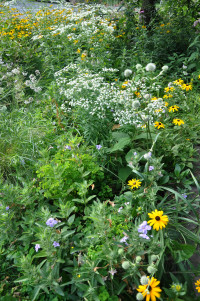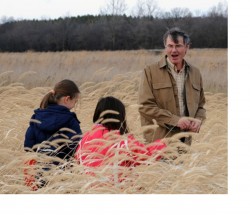Explore the Magical World of Native Plants
Have you ever walked by a beautiful garden brimming with blooms and butterflies and thought, I wonder how they did this? The upcoming Birds, Bees & Butterflies Native Garden Tour in Oak Park and River Forest will give you a chance to satisfy your curiosity and talk to the people behind their own gardens. Passionate native plant enthusiasts, master gardeners, professional designers and experienced naturalists will guide you through 12 enchanting gardens that creatively incorporate native plants.
It's Time to Plan a Green Event for Your Block Party!
Spring has sprung, the birds are singing and the flowers are blooming.
Host a green show & tell event at your block party to explore ways we can do our part to support Mother Nature. You can choose from one of the following topics offered by Green Community Connections and friends or design your own event.
Native Garden Tour Elicits 'Oohs and Ahs'
“Visitors loved seeing the goldfinches on the anise hyssop and cup plants, the monarchs landing on the swamp milkweed and bumblebees everywhere. There were literally ‘oohs and ahs,’” says garden host Adrian Fisher. With Mother Nature’s cooperation, the Interfaith Green Network, Green Community Connections and West Cook Wild Ones hosted a successful “Birds, Bees & Butterflies: A Native Garden Tour” in Oak Park and River Forest on August 6.
School Garden Symposium
Bringing Nature to Your Home
What do you see when you look out of your window? This butterfly took a moment to feed and rest in my Oak Park, IL yard. Every day this summer I’ve had visitors that entertain me. It could be the American goldfinch picking at cupplant seeds, a falcon swooping in for a rabbit, bees sipping nectar, and butterflies floating toward flowers.
Yesterday I counted ten goldfinch in my cupplants. The bees, so many different kinds I can’t name them, congregate on my swamp milkweed and cupplant flowers. Soon they’ll have to move on to my asters because the cupplants are going to seed. 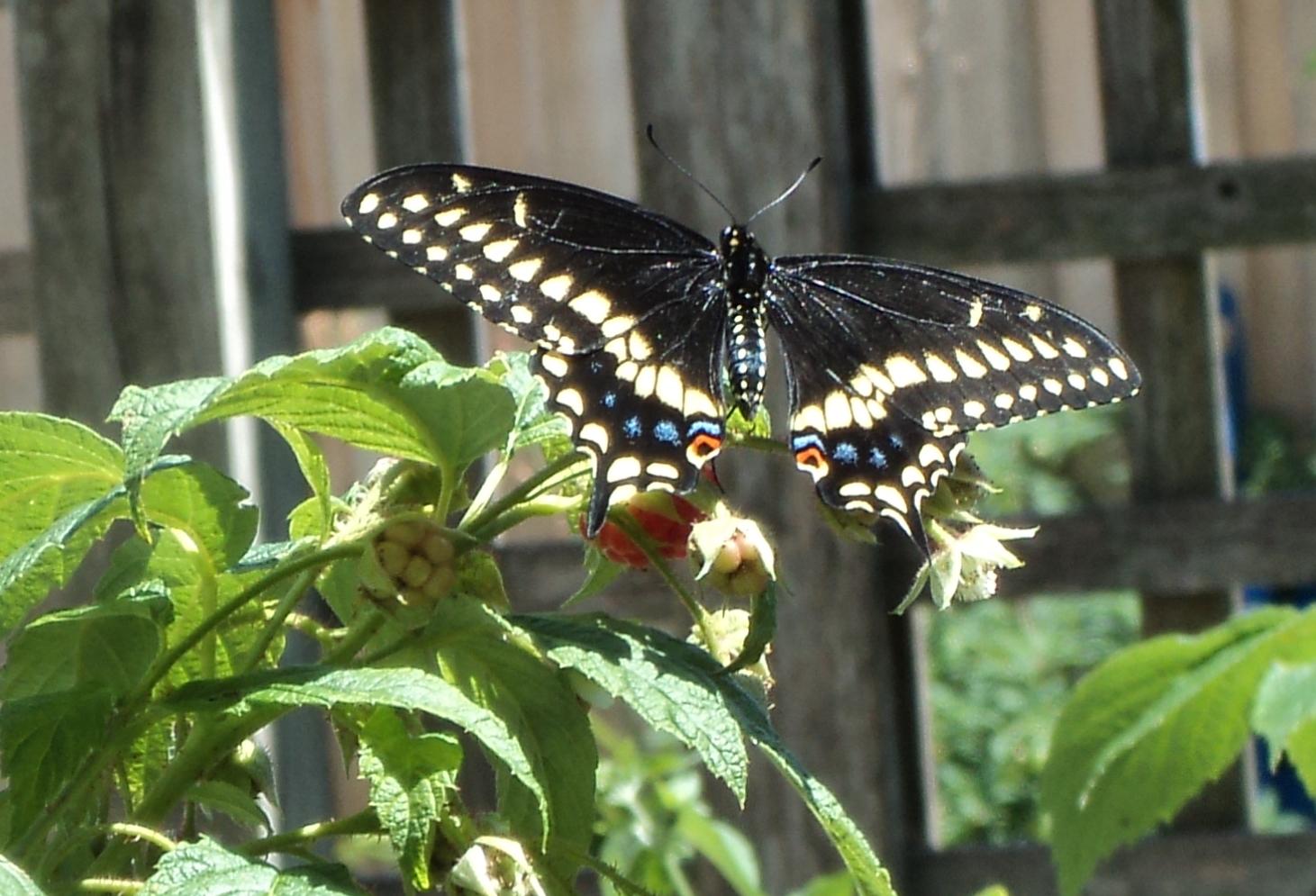 I wish I could adequately describe the butterflies. They float like a ballet dancer who is so light that even the breeze joins in the dance. They stop briefly and take in some nectar then move on to another flower. They sip from all of my flowers, as if their meal is only complete after tasting each one.
I wish I could adequately describe the butterflies. They float like a ballet dancer who is so light that even the breeze joins in the dance. They stop briefly and take in some nectar then move on to another flower. They sip from all of my flowers, as if their meal is only complete after tasting each one.
When I’m in my yard it’s hard to believe we’re facing the next great extinction.
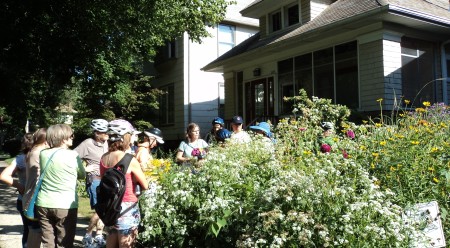
Could it be that a small yard in Oak Park can make a difference? I sat with my young friend from Stanford (recent graduate who majored in Earth Systems) on my back porch and wondered aloud about the falcons. She wisely observed that there were large trees all around from which a falcon could safely swoop to capture prey. I have since noticed that the falcon seems to originate from the cottonwood a couple of houses down.
I am a nature lover. My gardens host native plants and trees that create habitat for native wildlife. This is the time in our towns and villages for all of us to be nature lovers. It is nature that gives us all the resources we need to live. Bees and butterflies are especially vulnerable right now because of pesticides and herbicides that are killing their food sources. Birds depend on insects for 90% of their food.
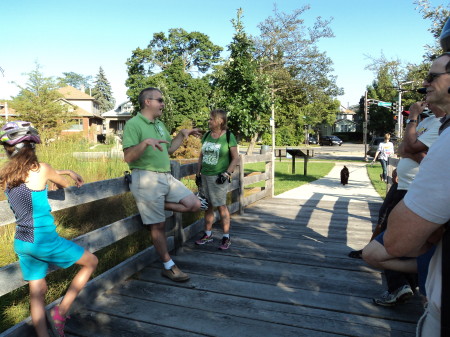
This September 7th Wild Ones and Green Community Connections hosted Birds, Bees & Butterflies: A Native Garden Tour. Over 140 members of our community visited eleven gardens showcasing native plantings that encourage and nurture our native wildlife. Our guided bike tour covered six miles across Oak Park with six stops. I imagine that next year’s bike tour will be able to cover shorter distances with many more gardens. During our tour folks talked about adding native gardens to their condo community yards, asked about purchasing plants and seeds, and took copious notes to incorporate natives into their own yards.
I can’t wait to bike around Oak Park and River Forest next spring and see all the nature lovers that have sprouted native gardens. For more information on bringing nature home to your yard visit www.westcook.wildones.org and www.greencommunityconnections.org.
Green Living: Enjoy the Birds, Bees & Butterflies on a Native Garden Tour
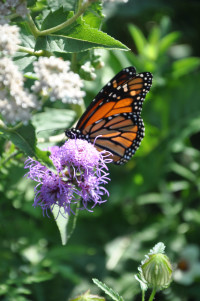 Green Community Connections and West Cook Wild Ones will present the first-ever “Birds, Bees & Butterflies: A Native Garden Tour” on Sunday, September 7, 2014, from 2:00 to 4:30pm. The tour concludes with a Native Garden Fair, from 4:00 to 5:30pm at the Forest Preserve District of Cook County located at the northwest corner of Lake and Harlem in River Forest. REGISTER NOW!
Green Community Connections and West Cook Wild Ones will present the first-ever “Birds, Bees & Butterflies: A Native Garden Tour” on Sunday, September 7, 2014, from 2:00 to 4:30pm. The tour concludes with a Native Garden Fair, from 4:00 to 5:30pm at the Forest Preserve District of Cook County located at the northwest corner of Lake and Harlem in River Forest. REGISTER NOW!
The Birds, Bees & Butterflies garden tour will feature 11 Oak Park and River Forest home and public landscapes that showcase various ways of integrating native plants, including: starter gardens, full-fledged prairie gardens, gardens designed to attract wildlife, those that harness rain water, and plants that invite children's involvement in the garden. Unique plants for shade, sun, rain gardens, clay soil and other applications will also be highlighted. Learn more about the specific gardens here.
A guided bike tour for a limited number of participants will be available. Or design your own self-paced tour with family and friends on foot, by bike, or by car, rickshaw or other vehicle of your choice. A donation of $7 per adult is suggested to help cover costs. Children are free.
Tour organizers want to encourage and support the rapidly growing interest in native plants and their important role in our ecosystem. Here are 5 reasons to join the tour:
- Get inspired and meet others in the community who share an interest in native plants.
- Learn how to get started with native plants if you've never used them before and get tips on maintaining a native plant garden.
- Learn how to integrate native plants into traditional landscaping.
- Find out where you can purchase native plants, and meet professionals who can help you.
- It will be fun!
The tour wraps up with a drop-in Native Garden Fair at the Forest Preserve District of Cook County General Headquarters at Lake and Harlem Avenues in River Forest from 4 to 5:30 p.m. Participants can enjoy refreshments, mingle with fellow native gardeners, learn more about native gardening and where to get native plants, obtain seeds to start now or in the spring, and sign up to be part of the exciting OPRF Wildlife Corridor, which will link Thatcher Woods with Columbus Park through residential native gardens. There will also be games and children's activities.
Free parking is available behind the Forest Preserve headquarters building, accessible from Bonnie Brae Place, one block west of Harlem.
Participants can register and pick up a map on the day of the tour at Cook County Forest Preserve at the northwest corner of Lake & Harlem.
Advance registration and additional details are available HERE.
We are looking for volunteers to help us put on this fun event. The volunteer slots are for various, short activities the day of the event. Please help us make this first-ever OP/RF tour a success!
Sign up to volunteer NOW.
Visit West Cook Wild Ones at www.facebook.com/wildoneswestcook and http://westcook.wildones.org/
Visit Green Community Connections @ www.greencommunityconnections.org and https:/www.facebook.com/GreenCommunityConnections
Community Profile: Meet Nature Advocate, Stephen Packard
Stephen Packard is for the birds. And we mean that in the best possible way. The founding director of Audubon Chicago Region and one of the most highly respected nature advocates in the Midwest will appear at Dominican University on Sunday, January 19, to speak about growing native plants in your yard to enjoy more visits from birds.
Stephen Packard has guided some of Illinois’ largest ecological restoration projects, assembled thousands of volunteers through his work with Illinois Nature Conservancy and Audubon, and founded some of our most important conservation institutions, including Chicago Wilderness and Friends of the Forest Preserves.
He has also experimented in his own Northbrook backyard for decades. His yard has become a sanctuary not only for an array of bird species, but also for his human neighbors, who enjoy hours of discovery and fulfillment.
Continue reading this illuminating interview with Stephen Packard.
Ultimately his goal is to help North America's bird populations, some of which desperately need human help to survive in the face of habitat destruction, global climate change and pesticides. We talked about the field of restoration ecology, why the work of habitat restoration demands a combination of patience and urgency, and what you can do in your own yard and beyond to support endangered wildlife.
Q: What is the field of ecological restoration?
S.P.: A journalist once asked one of our restoration volunteers, "What's the difference between restoration and gardening?" She answered, "With gardening, the fundamental principal is control. With restoration, it's surrender." We use a lot of the same techniques as gardening, but with restoration, you see yourself as a coach, not a boss. Things move in directions you're not expecting, and that's what exciting about it. You know you've succeeded when diverse plants and animals can reproduce and evolve their community mostly on their own. On the other hand you don't want a weed patch. Weeds do not form stable communities. They do not promote diversity.
Q: You sound like you are a patient man. Are you?
S.P.: You have to combine enormous patience with urgency. For the large number of endangered plants and animals that are barely hanging on, there is urgency to figure out what they need and provide it for them. Much of what we do takes many years to produce the results we're looking for—or the ones we're not looking for. Many plants take three to five years to grow big enough to flower and grow seeds big enough to plant.
Q: Tell us about your yard.
S.P.: I have a typical suburban lot, and it backs up to a forest preserve. A large part of my front and back yard is wild native plants. My neighbors like it. I get a lot of compliments. I was deliberate and slow about expanding it, and I made sure there were plenty of colorful flowers. In the front yard, all of my beds have mowed grass around them. In the backyard, my neighbors have encouraged me to expand into their yards. Many of them are also planting native patches in their yards. I always make sure we have plenty of milkweeds, which provide habitat for monarch butterflies. Most of the kids on my street, for a year or two of their childhoods, have raised monarchs from my yard. Here in wintertime, I see cardinals, chickadees, blue jays and juncos. In summertime, indigo buntings from the adjacent forest preserve nest here.
Q: What advice do you give to people who are intrigued by habitat restoration and would love to do this in their yards, but don't know where to start?
S.P.: If you are excited about attracting certain butterflies, put in the plant species they like. Start small, and advance year after year as you learn how things work in the soil, light and drainage you have.
Q: What are three things people don't know about Chicago wildlife?
S.P.: During spring migration time, birds come from tropical rainforests up to the Canadian tundra. This powerful force comes right through your yard every spring and fall! I strongly encourage people not to use insecticides, especially during migration season. Birds are totally vulnerable and have gone through so much to survive. If they die up here by eating a poisoned insect, it's such a sad thing. Second, plant seeds when they're ripe. Don't hold them until next spring. The seeds of wild plants are designed not to dry out, but to stay in soil over winter and then germinate in the spring. Finally, wildlife likes yards that are messy. When vegetation dies in the fall, leave it over winter. It will be full of birds and rabbits and voles. Think about how to design your garden so that the dead vegetation will be aesthetically pleasing.
Q: How can people who don't have a yard get involved?
S.P.: Visit habitatproject.org to learn about volunteering in public land wildernesses, the forest preserves and parks. Many people raise plants and donate seeds to habitat restoration projects on public lands.
Q: After more than 30 years in this field, are you still learning?
S.P.: One of the things that I'm continually impressed by is how long the processes are. We have planted areas in restoration projects and carefully monitored their diversity, and 30 years later the diversity is still increasing! The portion of rare plants is still increasing! Some plants that seem not to have done well show up 10 or 20 years later! Other new plants keep showing up; likely some bird has brought seed on their feet or the seed has blown in on a whirlwind. Sadly, last year, none of the monarchs in my yard survived, even the eggs we brought inside. There's something wrong. The adults laid eggs, and the eggs didn't hatch. Some of this is likely because there are new chemical insecticides being used. We've been raising monarchs for 15 years, and we've never seen this. If you are consistent for a long period of time, you learn things just because you notice changes.
You can meet Stephen Packard in person and hear more on January 19, 2014, from 2:30 pm to 4:30 pm in The Priory Room, Room 259, at Dominican University. The talk, hosted by West Cook Wild Ones, is free and open to the public, so bring a friend!
Wild Ones Program: Learn How to Attract Birds to Your Yard
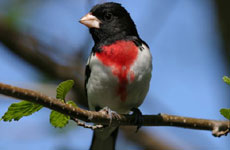 The West Cook Chapter of Wild Ones' January program will feature Steven Packard, Director of the Chicago Audubon Society, for a presentation on "How to Attract Birds to Your Yard." The meeting will be held January 19th, 2:30-4:30pm, at The Priory, Room 259, Dominican University, 7200 W. Division (corner of Division and Harlem) in River Forest. Program flyer.
The West Cook Chapter of Wild Ones' January program will feature Steven Packard, Director of the Chicago Audubon Society, for a presentation on "How to Attract Birds to Your Yard." The meeting will be held January 19th, 2:30-4:30pm, at The Priory, Room 259, Dominican University, 7200 W. Division (corner of Division and Harlem) in River Forest. Program flyer.
Why Native Wildflowers? – An Introduction
West Cook Wild Ones Presents "Why Native Wildflowers? – An Introduction" by Tim Lewis, Wild Ones National President,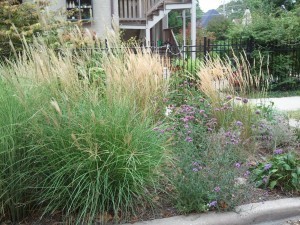 Sunday, November 10, 2:30-4:30 in Room 259, Priory Campus of Dominican University, 7200 W. Division Street, River Forest, Dominican's Priory Campus is just west of Harlem on Division Street in River Forest. Park in back and enter on the east side of the building.
Sunday, November 10, 2:30-4:30 in Room 259, Priory Campus of Dominican University, 7200 W. Division Street, River Forest, Dominican's Priory Campus is just west of Harlem on Division Street in River Forest. Park in back and enter on the east side of the building.
Why Natives is an introduction to landscaping using native plants. The presentation explains the history of our ecosystems, how we got to where we are today and why native plants are vital to the environment. The benefits and fallacies of natural landscaping will be explained. Finally, examples of native plant landscapes will inspire you to change your thinking about your own landscapes.
Tim Lewis is the national president of Wild Ones Natural Landscapers. He has been on the board of directors for over 10 years. Tim was president of the Rock River Valley chapter in Rockford for several years and served on the board for many more years. He is the past president of Four Rivers Environmental Coalition. Tim was named “Conservationist of the Year” for 2009 by the Sinnissippi Audubon Society. In 2011, he was a finalist for the Seth B. Atwood Memorial Park and Conservation Service Award and in 2012 was the recipient of this award.
He has been growing native plants in his yard since 1991. His yard contains over 100 species of native plants in prairie plots, rain gardens, and savanna and shade gardens.
Dominican's Priory Campus is just west of Harlem on Division Street in River Forest. Park in back and enter on the east side of the building.







